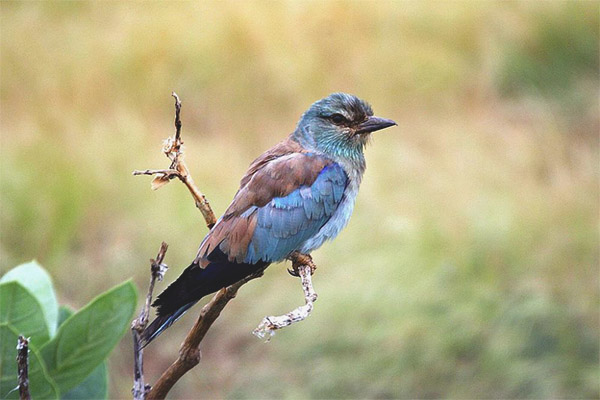The content of the article
Roller is a bird similar in size to daws. In addition, its size and shape of the beak also resembles a family of ravens. With the difference that it is painted in brighter colors. The bird is ranked as a squad of raksheobraznyh and belongs to the family of glaucous fungi. The total size of its body is 35 centimeters, the width of the wingspan of a bird reaches 67 centimeters. The average weight of an adult comes to 165 grams.
The plumage, located on its head and neck, as well as in the abdomen and the inner side of the wing, is represented by a greenish-blue shade. The back of this bird is covered with reddish-brown plumage, wing feathers, like the loins, are painted with dark brown color. The tail plume of the roller of a blue has a blue color, only a pair of feathers, located in the center of the tail, is brown, and the legs and beak of the bird are covered with a dark brown color.The coloring of young individuals completely coincides with the colors of the older tribesmen, only expressed in a dimmer tonality.
Feathers of a roller catcher are practically indistinguishable from males, they have the same size and characteristic color. These birds, despite the length of their legs, move extremely rarely and with great reluctance on the ground; they prefer to occupy positions on the upper floors of the forest and conduct close observation from there.
Favorite habitat
The roller roller is considered to be a migratory feathered because it often moves over long distances. It was widely distributed in the central and southern parts of the Eurasian continent. She also lives in northern Africa, and it can also be found in Europe. For wintering, most of these birds fly to Africa. They prefer their preference to hot areas with a dry climate. To build a nest of a high-quality roller house, places with a reliable cover are required, and for hunting it needs areas with open space.
Representatives of this species are lovers of sandy expanses that border forest areas,or include within their limits single groups of trees. They consider the hollows of old trees to be the best place for nesting. During the period of their nesting, they can choose a light pine forest for their settlements. A prerequisite for these birds is the presence of extensive glades or glades formed for power lines. Equally attractive to them may also be deciduous forests or mixed, if they are located on the coast of rivers or forest lakes.
Quite often, the roller print can be found on the forest edges, which are associated with open areas, such as fields or meadows, and perhaps the drained areas of the former swamps. The bird is not whimsical to the nature of the forest. The main condition she considers the presence of trees with a hollow and the neighborhood with open terrain, which she uses for hunting.
Given their habits, a bright bird will not go deep into the forest, because there is little that attracts her. But to arrange their nest in a single tree growing along the road or in a field, less often on the outskirts of the settlements, it can easily, provided that there is a hollow in this tree.
The period of breeding chicks
From the wintering grounds, the rollers fly from mid-April to mid-May and settle in single pairs. In the conditions of Eastern Europe, it settles exclusively in the hollows of trees, it rarely occupies a hollow of a desirable or green woodpecker, but prefers places in old trees of natural origin. The height of the hollow of a bird can range from 2.5 to 12 meters from the soil level. Inside the lazy bird does not suit the special litter, it will put aside its laying directly into the wooden dust, or use the nest of the previous owners for this.
The brickwork of the sergeonfish contains from 3 to 6 eggs, but more often there are 4 of them, the eggs are elliptical in shape and are enclosed in a white shell, with a glossy coating. The approximate weight of an egg is 15 grams with a size of 36 millimeters in length and 30 millimeters in width. The bird is able to carry one egg per day.
The nesting period of birds of this species has stretched boundaries; it is not difficult to find fresh laying in the middle of May and in the twentieth of June. They hatch chicks once a season, both parents take part in hatching eggs.The incubation period lasts for 19 days. It is noteworthy that parents begin to sit on eggs after the last egg is laid, which leads to a one-time appearance of offspring.
Diet
The main objects of hunting of this bird are large insects and their larvae, less often they are not attracted by large lizards or frogs, although sometimes the bird can even catch a mouse. Eating in large quantities of large insects that are harmful to cultivated plants, it brings great benefits and deserves respect.
It is very interesting to watch when a bright bird hunts on a mouse. Having taken a high observant position on a tree, a top of a pole or a power line, the roller roller peers down attentively.Having spotted her prey, she quickly rushes down and grabs the mouse by the tail. The bird catches the caught mouse to the nearest tree and, continuing to hold its tail, beats with a sweep of its head on a hard surface. The predator will continue this procedure until it is satisfied that the mouse has given its ends, only after that the mouse will be swallowed whole.
Video: Roller (Coracias garrulus)












To send